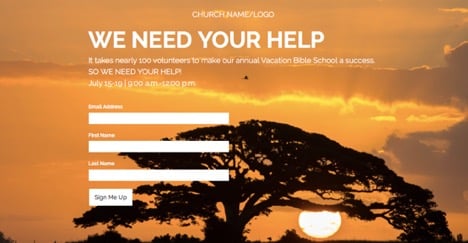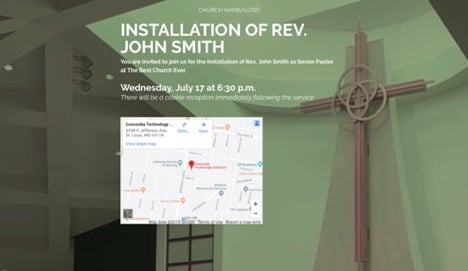.png?width=710&name=blog-landing-pages-achieve-your-goals%20(2).png)
In my last post, I laid out what landing pages are and why they are important in communicating to your target audience. I wrote about how the retail industry uses landing pages, and hopefully you did your homework to see how effectively the industry uses them to communicate targeted information to its customers.
For a church website, our final goal may not be the same as the general retail industry. Our goal, as Laura Horn wrote in How to Invite Website Visitors to Opt into an Ongoing Relationship, is to let people know they will find Jesus in the Church, and we want them to come and meet Him there." So, as we begin to build our landing pages, it is important to keep this at the top of our minds while applying the same effective techniques to our landing pages that the retail industry does.
Let’s jump in!
The first step to building a landing page is to decide if one is actually needed and if it is the best option. Ask yourself this question: do you need users to take a distinct action with a singular goal in mind? If you answer yes, then a landing page is a beneficial communication tool that will help you achieve this outcome.
What an effective landing page must have:• Simplicity
• No distractions
• Organized Information
• Content tailored to the target audience
• A strong message
• Consistency with your brand
• A call-to-action (CTA)
• Responsiveness (mobile-friendly)
What an effective landing page includes:
• A strong headline
• A sub headline
• A related image or video
• A clear message and instructions
• A CTA button, or form, if needed
A landing page can be built onto your website as long as you have the flexibility to make it look different than the rest of the site and hide it from the main navigation. Also, it is important to have some sort of tracking tool, such as Google Analytics, on the website to help you determine if the page is successful.
If your website does not have that capability, or if you have to pay a developer, I would suggest using a free platform. Many marketing tools that are used for email campaigns, such as HubSpot, Mailchimp, or Constant Contact, have a landing page option with premade templates. These platforms also offer tracking reports that help you see conversions and other detailed information. I strongly suggest making changes to any template used to ensure that it is consistent with your brand.
Next, a decision has to be made regarding how you are going to bring people to your page. Via email blast? Via specific link on social media? Via paid ads in Google for individuals who search for a key word?
Once you have made the page and have decided how to share it, you are ready to go!
Let’s take a moment to look at some fictitious landing pages used specifically for a church site.
Vacation Bible School
For many churches, Vacation Bible School has many moving parts. You need volunteers, you need in-kind donations, and, of course, you need parents or guardians to sign their children up to attend.
Volunteer sign-up landing page

This landing page is very simple and has all of the basic fields necessary to get the interested individual’s essential information. The confirmation message will let people know that there will be an incoming email with important details about volunteering. The email will also include information about how to complete a background check, possibly a list of open positions, an instruction video, and other important details. The users request this information by completing the form on the landing page above, which means that the users’ undivided attention should be had when details are shared in the resulting email.
This page is something that might be sent out in a targeted email to individuals of the congregation who have volunteered previously, and to anyone who is in the age range of the volunteer requirements. The subject line might read, “Will you be a part of the 100?” A link to this page could also be shared to the congregation’s social media accounts, since many of its members may be followers. Additionally, if the funds are available, a sponsored post of this page could be made on Facebook, specifically, targeting those who “like” the page.
A page for signing children up would look a little similar but include fields for more information. Many parents expect to put in more information when signing their child up for something, but be sure that you do not have too many information fields; this could overwhelm the user and cause form/page abandonment. Allergies, T-shirt orders, and emergency contacts could be requested through a follow-up email. This landing page could be sent to anyone who has registered for VBS before and to anyone in the congregation that has children in the VBS age range. A promoted post on Facebook could also target parents with children in that age range.
On your website, there should be an inside page that includes sign-up forms with all the required fields. Additional details and other information about VBS that may be important should also be included.
Special Service
Whether it is Easter, a guest music concert, or an installation, there are different types of special services a church might like for people to attend in addition to the regular schedule of services. A landing page can help communicate information about such services and help highlight their importance.

A page like this might be sent to congregation members and then shared to the congregation's social media pages.
Achieving Your Goals
We all have various goals in our ministry, and how we achieve them looks a little different for each of us. Landing pages are not the answer to everything. Too many landing pages will make your strategy less effective and take away from your message. They are a tool that helps communicate a clear idea to your audience in a way that delivers the information they seek, while making the audience take a specific action.
Guide the users and make sure that what you want them to do is communicated clearly. Also supply the users with the information they are looking for. Too often, we pack more information than necessary into one thing and our audience gets lost—no action is taken. Remember: keep your eye on the goal and use landing pages wisely. They will help your audience get the desired information, and help you move forward in achieving goals within your ministry.
Subscribe to the blog to receive notifications about more content like this.
























